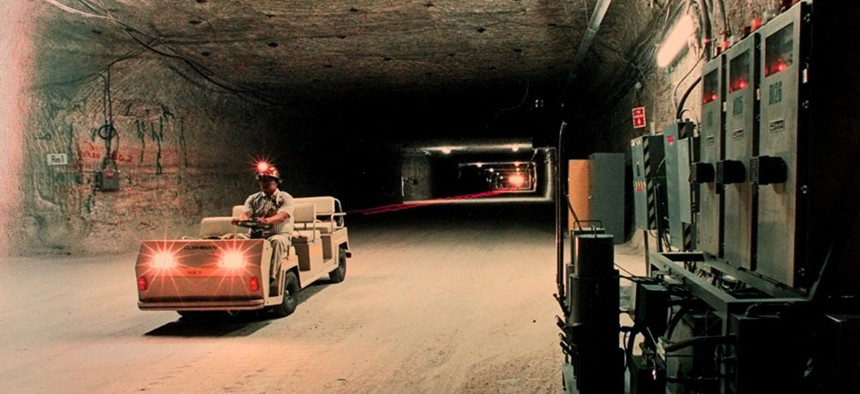Plutonium Leak Detected Near Underground Nuclear Waste Plant

worker drives an electric cart past air monitoring equipment inside a storage room of the Waste Isolation Pilot Plant in Carlsbad, N.M. AP file photo
The storage facility near Carlsbad, N.M., experienced a radiation leak and fire earlier this month.
Energy Department officials confirmed that trace leaks of plutonium have been detected in the air outside the country’s only underground nuclear waste repository, located 26 miles southeast of Carlsbad, N.M.
An independent monitoring organization first detected the leaks over the weekend after an air monitor within the storage facility, the Energy Department’s Waste Isolation Pilot Plant, detected radiation. The plant stores 3.2 million cubic feet of plutonium-contaminated waste in salt caverns 2,150 feet underground.
The Carlsbad Environmental Monitoring and Research Center, operated by the College of Engineering at New Mexico State University, said earlier this week it had detected trace amounts of plutonium and americium, a radioactive isotope, in an air filter from a sampling station located northwest of the storage site.
Joe Franco, Carlsbad field office manager for Energy, confirmed at a press conference this afternoon that the leak emanated from the underground facility where waste is packed into drums stored in the salt caverns.
Franco said it will be three weeks before officials are able to return underground to assess exactly what caused the leaks. During that time, Energy will develop safety plans to deal with potential radiation, health and mining hazards.
Ryan Flynn, secretary of the New Mexico Environment Department, told reporters attending the conference that “events like this should never happen . . . one event is too many.” He criticized Energy for waiting two days to inform his office that plutonium had been detected outside the facility.
The levels of plutonium radiation detected are “well below” levels that would be harmful to people of the environment, Flynn said.
Personnel from the center installed the air filter on Feb. 11 and removed for it analysis on Feb. 16. The analysis showed 0.64 Becquerels of americium (a Becquerel is a measure of radioactivity in which one nucleus decays per second), and 0.046 Becquerels of plutonium had been deposited on the filter.
The center has three monitors located around the plant. They have detected plutonium four times in the past, eventually determined to be fallout from nuclear weapons testing and detonations that occurred during the 1940s through the 1960s.
According to Russell Hardy, director of the research center, this is the first time plutonium has escaped from the facility in 15 years of operation.
Don Hancock, director of the Nuclear Waste Safety Program at the Southwest Research and Information Center, a nuclear watchdog group in Albuquerque, agreed that the leak should have never occurred and pointed out that the plutonium traveled at least a mile from underground to the CEMRC air monitor site.
The underground storage facility stores waste transferred by truck from Los Alamos National Laboratory, N.M., as well as Energy facilities in Idaho and Georgia. Last year, that amounted to nearly 1,000 separate shipments.
The facility closed for routine maintenance on Feb. 14 and was supposed to re-open March 10, when it would again start taking in waste shipments. Due to the leak, it will not take any new shipments as previously planned on March 10, Franco said. He could not say when it was likely to reopen.
This story has been updated.
NEXT STORY: How Government Data Is Fueling a New Economy






